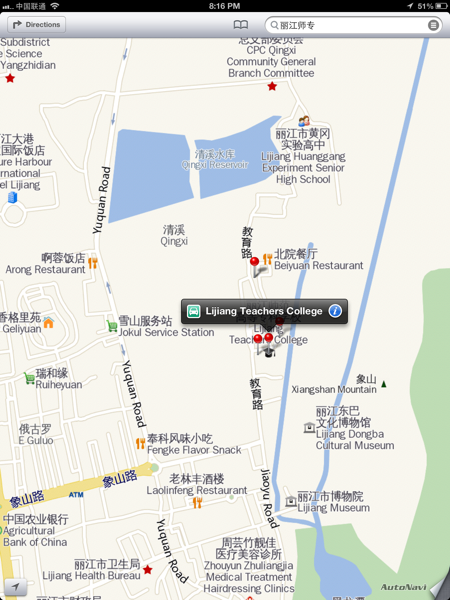iOS Maps and China
It seems like people really hate the new Maps in iOS 6. Now, I’m not disputing that Maps does give a lot of strange results to a lot of people all around the world, but for a large, large number of people, iOS 6 Maps has been a huge improvement over Google Maps. I’m talking about those of us who live in China (you know, the place with 1.3+ billion people and the second-largest economy in the world). Google Maps was always pretty terrible here. In the big cities and tourist centers, it was passable. Once you left China’s large metropolises, however, you were pretty much on your own. You could usually see expressways, highways, and even a lot of smaller roads, but there were very, very few shops, restaurants, banks, ATMs, etc. listed. That has changed with iOS 6. Apple has chosen AutoNavi to provide map services within China. That was a smart move, because AutoNavi is a local Chinese company that provides very detailed maps of China. Google was never going to be able to map China as well as it has other parts of the globe because the Chinese government doesn’t trust the motives of foreign companies—and it especially doesn’t trust Google. (see update below)
Well, don’t take my word for it. Check out the difference yourself. The first map is Google Maps on iOS 5. The second is Apple’s iOS Maps on iOS 6. This shows the same location just outside of Lijiang, Yunnan. Lijiang is one of the most popular tourist destinations in China. Both Google Maps and iOS Maps covers the center of the city pretty well. As you can see, though, if you move a couple of miles out of the city center, Google Maps becomes pretty useless pretty quickly.


Update: Looks like I was wrong about Google Maps not using data from AutoNavi. Google also used (some, all?) maps from AutoNavi. I still maintain that iOS 6 Maps is way better than iOS 5 Maps for users in China.
Update: People are taking me to task for saying that iOS 6 Maps is better than the previous Maps (powered by Google). As someone who lives in China and has to find my way around, the superiority of iOS 6 Maps is clear. In my experience, the new version of Maps zooms in much further, shows more points of interest, clearly labels banks and cellphone shops (China Mobile, China Unicom, and China Telecom), and gives the locations of ATMs and public restrooms (my original iPad running iOS 5 with Google-powered Maps doesn’t show either of those things). The killer feature, though, is that iOS 6 Maps shows both English names and Chinese characters for everything, whereas Google-powered Maps only shows the English translation (on iOS devices whose language is English). This is killer. English translations are almost useless in China because—guess what—Chinese people don’t speak English. For those of us who can read (at least some) Chinese, this feature is even more important. We can ask for places by name instead of just pointing at its location on a map. So, yes, I may have been wrong to say that Google doesn’t use AutoNavi’s maps (although, I can’t see how they use the same provider since Google-powered Maps and iOS 6 Maps show such wildly different maps for the same location), and for that I apologize. Nonetheless, looking at Google-powered Maps and iOS 6 Maps side-by-side, I would choose iOS 6 Maps every time.